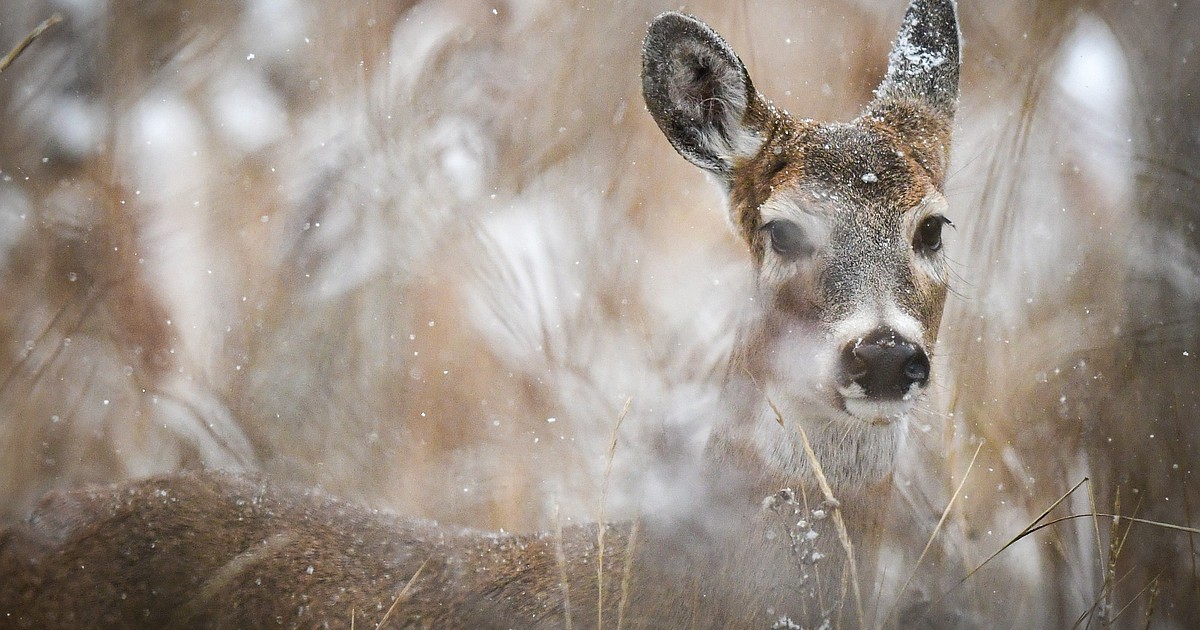Wildlife managers are reducing the number of white-tailed deer that hunters can kill in north-central Montana in response to recent reports of significant numbers of dead deer concentrated near water.
Within the past month, an unknown number of deer, mostly white-tailed deer, have succumbed to blue tongue virus or epizootic hemorrhagic disease (EHD), viral diseases that are most prevalent along waterways. Although the distribution of these viruses is “spotty,” it can be locally significant to ungulate populations in some regions, according to the Montana Department of Fish, Wildlife and Parks.
Here is what we know about these diseases, how they affect wildlife and what game managers are doing to ward off population declines.
Blue tongue and EHD are slightly different viruses, but both develop rapidly and result in internal bleeding in infected animals. Symptoms can include lethargy, poor appetite, drooling, dehydration and swelling of the tongue, head or neck.
Animals infected with either disease will sometimes hang their head and seek water sources to alleviate dehydration and fever. It’s not uncommon for animals to die within two weeks of becoming infected, according to FWP Game Management Division Chief Brian Wakeling, although animals can die a day or two after contracting an acute case.
Blue tongue and EHD are spread by midges (also sometimes called sand gnats, sand flies or no-see-ums) that breed in damp, muddy areas. The midges transmit the virus when they bite susceptible wild and domestic animals. Globally, blue tongue and EHD have been detected in white-tailed deer, mule deer, elk, moose, bighorn sheep, mountain goats, pronghorn, cattle and domestic sheep.
Midge populations tend to peak in late summer and early fall. Reports of deaths associated with the viruses typically decline a week or two after a deep, midge-killing freeze. Robinson, who delivered a commission report on behalf of Region 7 Commissioner Bill Lane, noted that “prolonged, unseasonably warm” weather this fall has contributed to the spread of the viruses.
Humans are not susceptible to the disease, though they are advised not to eat the meat of an animal if blue tongue or EHD is suspected. FWP also directs people not to feed potentially infected animals to their pets.
FWP biologists and members of the Fish and Wildlife Commission reported this week that they’re receiving reports of localized outbreaks along the Milk, Lower Yellowstone and Lower Clark Fork rivers.
Wakeling told commissioners that the department typically sees some measure of blue tongue and EHD every year, but it tends to be patchy. Region 6, which spans from north-central Montana to the northeast corner of the state, has been hit hardest by the viruses this year.
“We’re certainly seeing it in places we’ve never seen it before, but we’re not seeing it at a level that’s a concern for the population from a biological standpoint,” Wakeling told commissioners at their meeting Thursday.
Commission Chair Leslie Robinson of Dodson said she’d spoken with one landowner in Region Six who had personally counted 60 dead deer on his property. Another told her that he’s reluctant to go outside “because of the smell of all the deer they’ve lost.”
“I know we’ve had this before, but it’s very bad in Region 6,” she said. “Very few live deer are being spotted in areas where this is happening. … The areas that are being affected along the Milk River, mainly, are extreme this year.”
Wakeling wrote in an email to MTFP that the department doesn’t have an estimate of the number of animals that have died due to the difficulty in quantifying its reach.
“It can be locally significant, but it is not spread throughout the range,” Wakeling wrote, adding that white-tailed deer have been hit harder than mule deer or antelope.
Wakeling wrote that 49 samples have been sent to the state’s wildlife lab in Bozeman for testing. About half of the samples are still being processed. Of the 21 samples analyzed, 14 tested positive for one or both viruses. Wakeling added that there is a possibility that some of the negative detections could be false negatives due to the decomposed nature of the samples.
How are wildlife managers responding?
At the recommendation of FWP wildlife biologists, the commission unanimously voted Thursday to reduce the number of white-tailed deer tags that Region 6 hunters can purchase.
Effective Oct. 10, hunters won’t be allowed to purchase more than one “B” license to hunt white-tailed deer in Region 6. A B license allows a hunter to harvest additional does. The department is also capping the maximum number of regional white-tailed B licenses that can be issued at 2,000. Under the regulations the commission adopted in December of 2023, a hunter with the right collection of tags was authorized to kill up to four white-tailed does in Region 6.
Robinson expressed concern that Region 6 hunters might shift their hunting efforts to mule deer, which she said are just starting to recover from a multi-year decline. Outside of instituting emergency closures in some districts, the commission’s ability to avoid an overharvest of deer in response to the disease outbreak is somewhat limited by the fact that many hunters already have their tags in hand, she said.
Hunters who have already purchased B licenses for white-tailed deer in Region 6 can still use them. At Robinson’s recommendation, FWP said it would disseminate a map indicating where blue tongue or EHD have occurred to encourage hunters to focus their efforts on other areas of the state.
Archery season started Sept. 6. The general rifle season for deer and elk begins Oct. 25.

